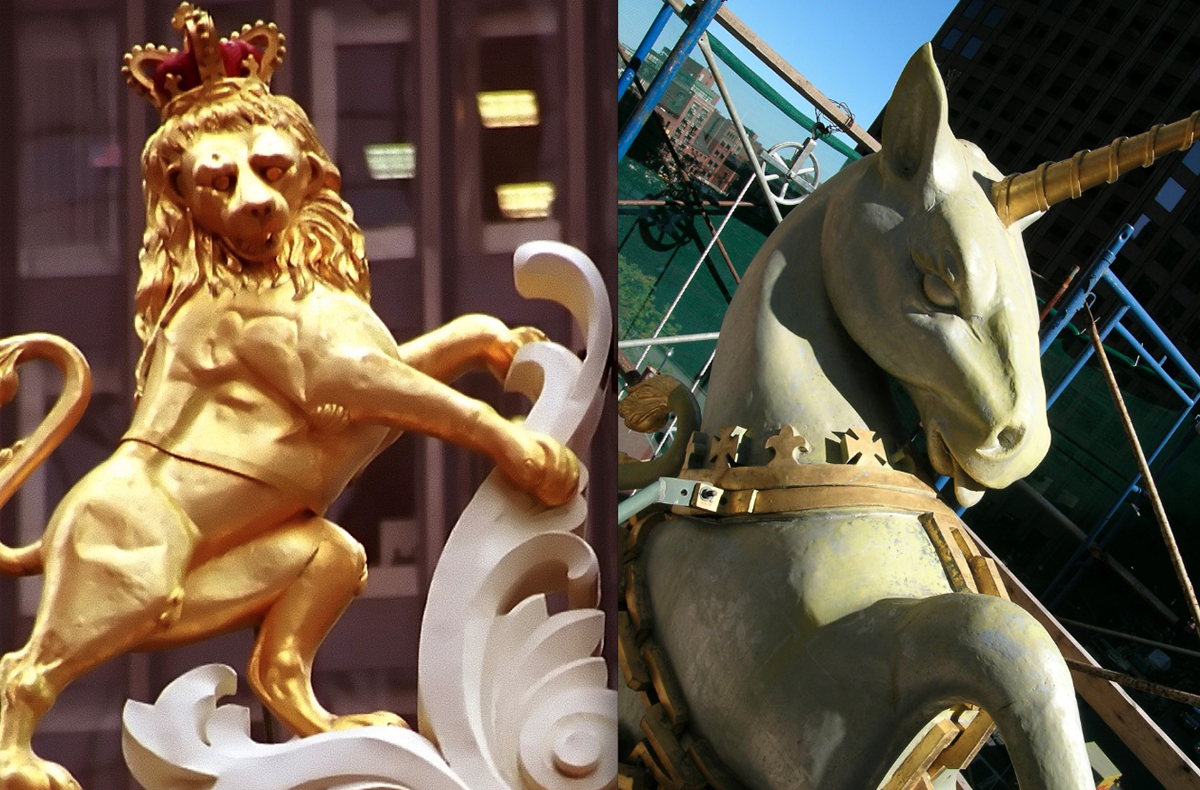An Eerie Coincidence Between Scotland’s Vote and the Old State House

Images Courtesy of David Ohmer on Flickr/Bostonian Society
Call it a curse, or maybe call it a blessing, but whatever it is, some historians can’t ignore the fact that the weather-beaten statues on top of the Old State House in Boston—a lion representing English rule, and a unicorn symbolizing Scotland’s monarchy, together signifying the two countries’ storied relationship for more than 300 years—came down for restoration as Scottish voters are considering claiming independence from the United Kingdom.
“It’s really crazy, isn’t it?,” said Nat Sheidley, a historian for the Bostonian Society, the non-profit group that’s in charge of preserving the building. “There’s certainly an interesting story to tell there.”
The two life-sized statues are currently at Skylight Studios in Woburn, where sculptor Bob Shure will reguild the lion with a coat of 23-carat gold, and touch up the unicorn with a new layer of palladium silver.
Meanwhile, more than 3,000 miles away in Scotland, residents are hitting the polls to vote for or against independence from the United Kingdom, which, if they choose the former, would give them greater control over governmental operations and signify a divide between England and Scotland’s political union that was first formed in the 1700s. Thursday’s historic vote, which some say could cause political and economic after shocks felt around the world, coincides with the restoration of the two historic signifiers representing both foreign countries.
The current copper-based lion and unicorn that adorn the Old State House are replicas of the first statues that were installed when the building was constructed in 1713, just years after the passage of the “Act of Union,” a deal that brought together England and Scotland’s parliaments to form the UK, which now hangs in the balance. The statues undergoing restorations were placed on the Old State House in 1901, and with them, a third statue of a bald eagle on the West facade, adding to the building America’s relationship to the other two countries.
“It is curious, isn’t it, that England and Scotland have managed to remain part of a United Kingdom for 307 years, joined heraldically by the statues of two symbolic creatures mounted atop the oldest public building here in the city that we all understand is the Hub of the universe,” said Brian LeMay, president and executive director of the Bostonian Society. “And can it be a coincidence that, only after the Bostonian Society concluded that it would be imperative to restore these charismatic megafauna, do the people of Scotland organize a vote to restore their independence?”
The Bostonian Society said they “certainly didn’t plan” the restoration process around Scotland’s vote, but the timely event sheds light on the importance of a history that connects England, Scotland, and even Boston, dating back three centuries.
“It’s a great opportunity for us to focus our attention on something that’s of world historical significance happening on the other side of the Atlantic, and it’s significance to the history here,” said Sheidley. “… There’s a funny little connection to be made there. When these go back up, we will either be acknowledging the durability of the very idea of British-ness, or marveling at the this watershed moment that has quite unexpectedly come upon us.”


